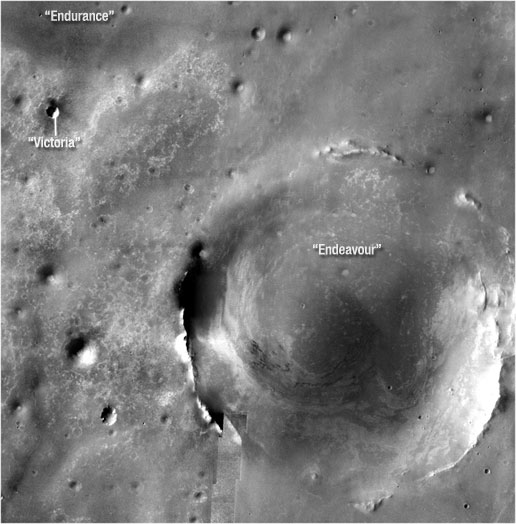

The Big Drive to Endeavour-crater. Credit: NASA/JPL
[/caption]
Opportunity, the intrepid Mars Exploration Rover, is going to put the pedal to the metal and head out for a crater nearly 12 kilometers (7 miles) away. That would match the distance the rover has traveled since landing in 2004. But the call of the unknown is compelling the rover science team to make the attempt. “We may not get there, but it is scientifically the right direction to go anyway,” said Steve Squyres, principal investigator for the science instruments on Opportunity and its twin rover, Spirit. For an “aging” rover (what age is 4 in rover years?), this might be setting the bar pretty high. But maybe it’s the journey and not the destination.
“This is a bolder, more aggressive objective than we have had before,” said John Callas, the project manager the rovers. “It’s tremendously exciting. It’s new science. It’s the next great challenge for these robotic explorers.”
“This crater is staggeringly large compared to anything we’ve seen before.” The crater, named Endeavour, is 22 kilometers (13.7 miles) across. “I would love to see that view from the rim,” Squyres said. “But even if we never get there, as we move southward we expect to be getting to younger and younger layers of rock on the surface. Also, there are large craters to the south that we think are sources of cobbles that we want to examine out on the plain. Some of the cobbles are samples of layers deeper than Opportunity will ever see, and we expect to find more cobbles as we head toward the south.”
The rover team estimates Opportunity may be able to travel about 110 yards each day it is driven toward the Endeavour crater. Even at that pace, the journey could take two years. But why not go for it, and see how long the rovers can last?
One is imaging from orbit of details smaller than the rover itself, using the High Resolution Imaging Science Experiment (HiRISE) camera on NASA’s Mars Reconnaissance Orbiter, which arrived at the Red Planet in 2006.
“HiRISE allows us to identify drive paths and potential hazards on the scale of the rover along the route,” Callas said. “This is a great example of how different parts of NASA’s Mars Exploration Program reinforce each other.”
Also, Opportunity now has a better “brain” for driving across the the plains of Mars. A new version of flight software uplinked to Opportunity and Spirit in 2006, boosts their ability to autonomously choose routes and avoid hazards such as sand dunes.
During its first year on Mars, Opportunity found geological evidence that the area where it landed had surface and underground water in the distant past. The rover’s explorations since have added information about how that environment changed over time. Finding rock layers above or below the layers already examined adds windows into later or earlier periods of time.
Source: JPL
NASA continues to progress with the development of the Nancy Grace Roman Space Telescope (RST),…
Our neighbour, the Large Magellanic Cloud (LMC), is rich in gas and dust and hosts…
New research on locomotion techniques that could be used in space exploration is constantly coming…
White dwarfs are the remnants of once brilliant main sequence stars like our Sun. They're…
We all know that asteroids are out there, that some of them come dangerously close…
It’s a familiar sight to see astronauts on board ISS on exercise equipment to minimise…